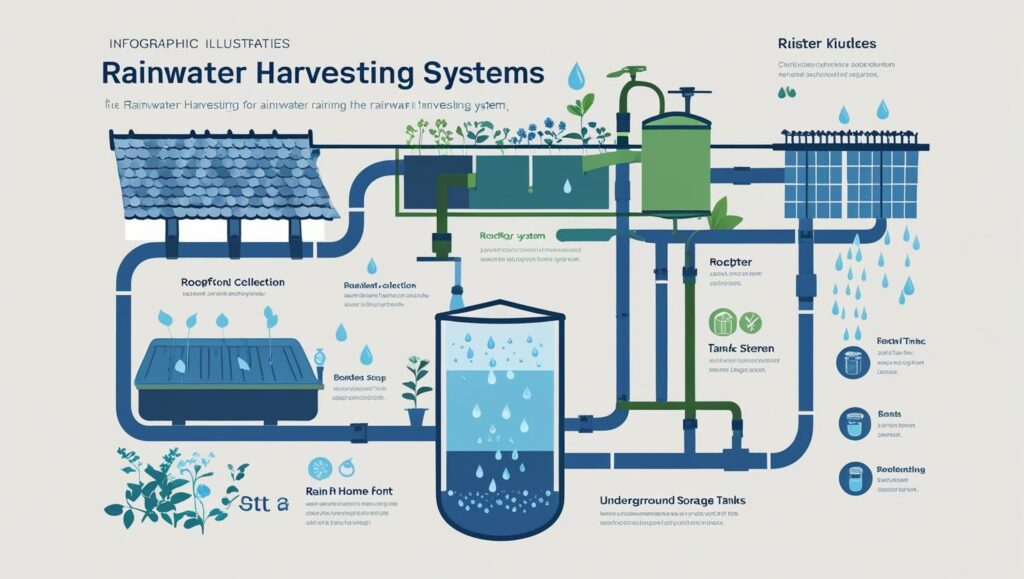Unlock the Power of Rainwater: Benefits and Setup of Rainwater Harvesting Systems
Imagine a world where your garden thrives without relying on municipal water, or where your toilet flushes using a resource that literally falls from the sky. This isn’t a futuristic dream; it’s the practical reality offered by **rainwater harvesting systems**. As concerns about water scarcity grow and utility bills climb, collecting and utilizing rainwater is emerging as an incredibly smart, sustainable, and cost-effective solution for homes and businesses alike. If you’ve ever wondered how to tap into this abundant natural resource, you’re in the right place. This comprehensive guide will walk you through the compelling benefits and practical steps of setting up your very own rainwater harvesting system.
Why Consider Rainwater Harvesting? The Myriad Benefits
The allure of collecting rainwater goes far beyond just being an eco-friendly trend. There are tangible, impactful benefits that make **rainwater harvesting systems** an increasingly attractive option for savvy homeowners and environmentally conscious individuals.
Economic Advantages: Saving Money Where It Matters
- Reduced Water Bills: This is perhaps the most immediate and tangible benefit. By using harvested rainwater for non-potable needs like irrigation, toilet flushing, and laundry, you significantly decrease your reliance on expensive municipal water, leading to noticeable savings on your monthly utility bills.
- Decreased Demand on Municipal Supplies: In areas facing water restrictions or escalating water costs, rainwater harvesting provides a reliable alternative source, reducing strain on local water infrastructure.
- Potential for Off-Grid Living: For those looking to minimize their dependence on public utilities, a robust rainwater harvesting system can be a crucial step towards self-sufficiency.
Environmental Impact: A Sustainable Choice
- Water Conservation: Every drop of rainwater collected means one less drop of treated drinking water is used for non-essential purposes. This directly contributes to conserving vital freshwater resources.
- Reduced Stormwater Runoff: Rainwater harvesting helps manage stormwater by diverting it from overloaded drainage systems. This reduces erosion, prevents localized flooding, and minimizes the pollution carried into rivers and lakes.
- Lower Carbon Footprint: The energy required to pump, treat, and deliver municipal water is substantial. By using rainwater, you indirectly reduce your carbon footprint associated with water consumption.
Water Quality and Plant Health
- Chemical-Free Water for Plants: Unlike treated tap water, rainwater is naturally soft and free of chlorine, fluoride, and other chemicals. This makes it ideal for gardens, lawns, and houseplants, promoting healthier growth and reducing chemical buildup in the soil.
- Supplemental Water Source: During droughts or water restrictions, a rainwater collection system can provide a critical backup, ensuring your garden, landscape, or even livestock have a water supply.
Clearly, the advantages of installing **rainwater harvesting systems** are compelling from both a financial and an environmental perspective.
Getting Started: Essential Components of a Rainwater Harvesting System
Setting up a basic **rainwater harvesting system** is more straightforward than you might think. While complex systems exist, a functional setup for home use generally involves a few key components.
1. Catchment Surface: Your Roof is Your Collector
- Roof Type: Most roof types are suitable for collecting rainwater, though some, like asphalt shingles, may require more robust filtration due to granule shedding. Metal roofs are often considered ideal.
- Guttering: Clean, well-maintained gutters are essential for directing water from your roof to your storage. Ensure they are free of leaves and debris.
2. Conveyance System: Guiding the Flow
- Downspouts: These connect your gutters to your storage container. It’s crucial they are properly sized and positioned to handle peak rainfall.
- First-Flush Diverters: This is a critical component. The “first flush” of rain often contains accumulated debris, dust, and pollutants from your roof. A first-flush diverter diverts this initial contaminated water away from your main storage, ensuring cleaner water collection.
3. Filtration: Ensuring Water Quality
- Gutter Guards/Screens: Prevent larger debris like leaves, twigs, and bird droppings from entering your gutters and downspouts.
- In-Line Filters: Positioned before your storage tank, these filters remove smaller particles. The type of filter depends on the intended use of the water (e.g., a simple mesh screen for irrigation, finer filters for indoor use).
- Leaf Catchers: These are specialized filters that remove leaves and other larger organic matter before water enters the downspout.
4. Storage: The Heart of the System
- Rain Barrels: For small-scale use (e.g., garden watering), single or linked rain barrels are a popular and affordable option. They are typically placed at the base of a downspout.
- Storage Tanks/Cisterns: For larger volumes and more extensive use, dedicated above-ground or underground tanks are used. These come in various materials (plastic, concrete, fiberglass) and sizes.
- Location: Consider accessibility for maintenance, proximity to usage points, and protection from direct sunlight (to prevent algae growth).
5. Distribution System: Getting Water Where It’s Needed
- Gravity-Fed Systems: For simple applications like garden watering, gravity can be sufficient if your storage is elevated.
- Pumps: For higher pressure applications (e.g., connecting to a toilet flush or outdoor spigot), a small pump will be necessary.
- Hoses and Irrigation Lines: Connect these to your distribution point to direct the water to its final use.
Each of these components plays a vital role in the efficiency and effectiveness of your **rainwater harvesting system**.
Planning Your Rainwater Harvesting System: Key Considerations
Before you start buying components, a bit of planning will ensure your **rainwater harvesting system** meets your specific needs and local regulations.
1. Determine Your Water Needs
- Usage: What do you plan to use the water for? Gardening? Toilet flushing? Laundry? This will dictate the size of your storage and the level of filtration needed.
- Demand: Estimate your daily or weekly water requirements for these uses.
2. Assess Your Catchment Potential
- Roof Size: A larger roof area means more potential for water collection.
- Average Rainfall: Research the average annual rainfall in your area. This will help calculate how much water you can realistically collect. (A simple formula: square footage of roof x average annual rainfall (in feet) x 7.48 gallons/cubic foot = total gallons collected).
3. Choose the Right System Size and Type
- Scale: From a single rain barrel to a multi-tank commercial system, match the scale to your needs and budget.
- Above-Ground vs. Underground: Above-ground tanks are easier to install and maintain but take up visible space. Underground tanks are hidden but require excavation.
4. Local Regulations and Permitting
- Check Local Ordinances: Some municipalities have specific regulations or require permits for **rainwater harvesting systems**. Always check with your local authority before installation.
- Rebate Programs: Some areas offer rebates or incentives for installing rainwater harvesting systems.
5. Maintenance Matters
- Regular Cleaning: Gutters, downspouts, and filters need regular cleaning to prevent blockages and maintain water quality.
- System Checks: Periodically inspect pipes, pumps (if any), and tanks for leaks or damage.
- Winterization: In colder climates, ensure your system is properly drained and protected from freezing during winter months.
Proper planning ensures your **rainwater harvesting system** is efficient, legal, and low-maintenance.
Embracing a Sustainable Future with Rainwater
Installing a **rainwater harvesting system** is more than just a home improvement project; it’s a step towards greater self-sufficiency, environmental stewardship, and significant cost savings. Whether you start with a simple rain barrel for your garden or invest in a comprehensive system for indoor use, harnessing the power of precipitation offers undeniable benefits. By making this sustainable choice, you’re not only reducing your utility bills but also contributing to a more resilient and water-wise community. Ready to take control of your water future? Begin your rainwater harvesting journey today and witness the remarkable impact it can have on your home and the planet.



